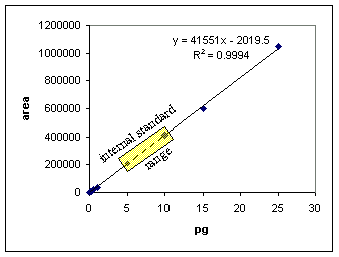The Internal Standard
|
|
An internal standard should be used when performing
MS quantitation. An appropriate internal standard will control for
extraction, HPLC injection and ionization variability. In a
complex matrix it is not uncommon for two different standard levels to give nearly
an identical response, especially at the low end of the curve. It is only when an internal standard is
used that the two points can be differentiated. However, some researchers
attempt to prepare standard curves and run samples without an internal
standard and find moderate success. Often without an internal
standard % RSDs of replicates can be as high as 20%. Using an internal
standard the % RSDs can be brought down to approximately 2%. We run
triplicates at each level of our standard curve.
How do I choose an internal standard? The best internal standard is an isotopically labeled version of the molecule you want to quantify. An isotopically labeled internal standard will have a similar extraction recovery, ionization response in ESI mass spectrometry, and a similar chromatographic retention time. If you are performing non-clinical PK quantitation it may be difficult to justify such a standard since a special synthesis of an isotopically labeled standard can be expensive and time consuming. Often if you are working with medicinal chemists they will have a library of compound analogs that can be used as internal standards. These analogs were made in the evolution of the compound to be tested and will be similar to the compound to be quantified and more importantly will be slightly different by parent mass. Try to avoid using de-methylated (-14) or hydroxylated (+16) analogs as internal standards since these are the most common mass shifts observed in naturally occurring metabolites of the parent compound. For small molecule quan a common internal standard is a chlorinated version of the parent molecule. A chlorinated version of the parent molecule will commonly have a similar chromatographic retention time which is an important characteristic of an internal standard. We have found that one of the most important characteristics of an internal standard is that it co-elutes with the compound to be quantified. How do I use an internal standard? First of all an internal standard should be added at the beginning of the sample work-up, typically before the plasma crash or solid phase extraction. The internal standard should be added at the same level in every sample including the standards. An internal standard should give a reliable MS response. Care should be taken that the amount of the internal standard is well above the limit of quantitation but not so high as to suppress the ionization of the analyte. "How much internal standard should I add?", this is an important question. It pays to know roughly how much compound is in your sample. This can be accomplished by making trial analyses of an early, middle and late time point with perhaps one or two standard points. This information will be very valuable when building an appropriate standard curve and in knowing how much internal standard to add. If you were trying to quantify samples in the range of 100 fg to 25 pg and the limit of detection was 100 fg you might add 5 to 10 pg of internal standard to every sample. A good rule of thumb is to target the internal standard to the lower 1/3 of the working standard curve. This is a range that will give a comfortable response without interfering with the ionization of the analyte, see Figure 1. |
|
Placement of the Internal Standard
|
|
|
|
Learn About |
|
|
|
home
| disclaimer |
